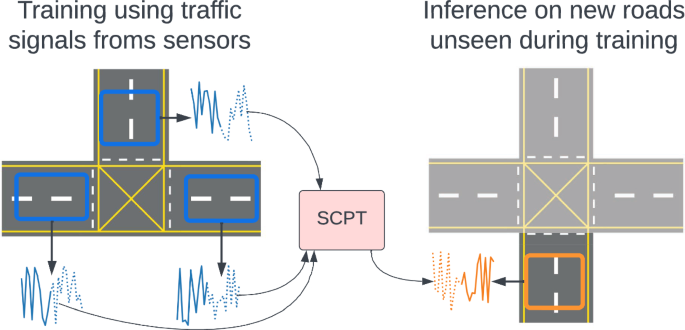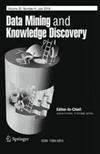基于空间对比预训练(SCPT)的新道路交通预测
IF 4.3
3区 计算机科学
Q2 COMPUTER SCIENCE, ARTIFICIAL INTELLIGENCE
引用次数: 1
摘要
新的道路一直在修建。然而,以前的深度预测模型推广到训练数据中未见的新道路(看不见的道路)的能力很少被探索。在本文中,我们引入了一种称为时空分裂的新设置来评估模型推广到未知道路的能力。在这种设置中,模型在来自道路样本的数据上进行训练,但在训练数据中没有看到的道路上进行测试。此外,我们还提出了一种新的框架,称为空间对比预训练(SCPT),其中我们引入了一个空间编码器模块,在推理时间内从未见的道路中提取潜在特征。这个空间编码器是使用对比学习预训练的。在推理过程中,空间编码器只需要新道路上两天的交通数据,不需要任何重新训练。我们还表明,在推理时间内,空间编码器的输出可以有效地用于推断未知道路上的潜在节点嵌入。SCPT框架还加入了一个新的层,称为空间门控附加层,以有效地将空间编码器输出的潜在特征与现有主干相结合。此外,由于看不见的道路上的数据有限,我们认为最好将交通信号解耦为易于捕获的周期信号和难以捕获的马尔可夫信号,并且空间编码器只学习马尔可夫信号。最后,我们在四个真实数据集上使用ST分割设置对SCPT进行了实证评估。结果表明,将SCPT添加到主干中可以持续提高对未知道路的预测性能。更重要的是,在进一步预测未来时,这种改进会更大。代码可在GitHub上获得:https://github.com/cruiseresearchgroup/forecasting-on-new-roads。本文章由计算机程序翻译,如有差异,请以英文原文为准。

Traffic forecasting on new roads using spatial contrastive pre-training (SCPT)
Abstract New roads are being constructed all the time. However, the capabilities of previous deep forecasting models to generalize to new roads not seen in the training data (unseen roads) are rarely explored. In this paper, we introduce a novel setup called a spatio-temporal split to evaluate the models’ capabilities to generalize to unseen roads. In this setup, the models are trained on data from a sample of roads, but tested on roads not seen in the training data. Moreover, we also present a novel framework called Spatial Contrastive Pre-Training (SCPT) where we introduce a spatial encoder module to extract latent features from unseen roads during inference time. This spatial encoder is pre-trained using contrastive learning. During inference, the spatial encoder only requires two days of traffic data on the new roads and does not require any re-training. We also show that the output from the spatial encoder can be used effectively to infer latent node embeddings on unseen roads during inference time. The SCPT framework also incorporates a new layer, named the spatially gated addition layer, to effectively combine the latent features from the output of the spatial encoder to existing backbones. Additionally, since there is limited data on the unseen roads, we argue that it is better to decouple traffic signals to trivial-to-capture periodic signals and difficult-to-capture Markovian signals, and for the spatial encoder to only learn the Markovian signals. Finally, we empirically evaluated SCPT using the ST split setup on four real-world datasets. The results showed that adding SCPT to a backbone consistently improves forecasting performance on unseen roads. More importantly, the improvements are greater when forecasting further into the future. The codes are available on GitHub: https://github.com/cruiseresearchgroup/forecasting-on-new-roads .
求助全文
通过发布文献求助,成功后即可免费获取论文全文。
去求助
来源期刊

Data Mining and Knowledge Discovery
工程技术-计算机:人工智能
CiteScore
10.40
自引率
4.20%
发文量
68
审稿时长
10 months
期刊介绍:
Advances in data gathering, storage, and distribution have created a need for computational tools and techniques to aid in data analysis. Data Mining and Knowledge Discovery in Databases (KDD) is a rapidly growing area of research and application that builds on techniques and theories from many fields, including statistics, databases, pattern recognition and learning, data visualization, uncertainty modelling, data warehousing and OLAP, optimization, and high performance computing.
 求助内容:
求助内容: 应助结果提醒方式:
应助结果提醒方式:


